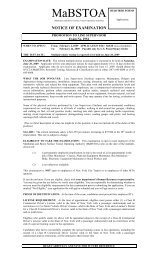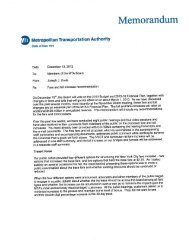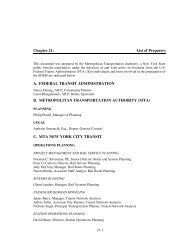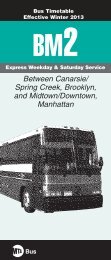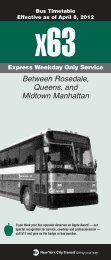Greening Mass Transit & Metro Regions: The Final Report - MTA
Greening Mass Transit & Metro Regions: The Final Report - MTA
Greening Mass Transit & Metro Regions: The Final Report - MTA
Create successful ePaper yourself
Turn your PDF publications into a flip-book with our unique Google optimized e-Paper software.
30<br />
TRANSFORMATIONAL RECOMMENDATIONS<br />
Recommendation 1. Adopt LEED Silver Standards for All Applicable <strong>MTA</strong> Buildings<br />
Expanding on the green innovations of its LEED-certified Corona Maintenance Shop and other recent projects, the <strong>MTA</strong><br />
should pioneer high-performance designs for all of its system facilities. To this end, the Commission urges that the <strong>MTA</strong><br />
adopt LEED Silver standards or higher for all new building projects, new construction, and major renovations wherever<br />
applicable. And the <strong>MTA</strong> should either recommission existing buildings or pursue certifications as LEED Existing Buildings:<br />
Operations and Maintenance (LEED-EB) where possible. For existing facilities, the <strong>MTA</strong> should determine which buildings<br />
can be adapted to the LEED-EB criteria and then pursue recommissioning according to a prioritized schedule.<br />
Recommendation 2. Develop New Green Design Standards for <strong>Transit</strong> Facilities<br />
Since the current LEED categories do not cover transit-specific infrastructure, such as stations, electrical substations, and<br />
pump rooms, the <strong>MTA</strong> should develop its own green building guidelines for facility design and renovation. <strong>The</strong> <strong>MTA</strong> Green<br />
Building Guidelines should be drafted in consultation with the USGBC and offered as a model for transit agencies nationwide.<br />
<strong>The</strong> <strong>MTA</strong> should then propose that the guidelines form the basis of a new LEED for <strong>Transit</strong> standard for transit facilities not<br />
covered by existing LEED programs, thus disseminating the standards through an independent auditing organization. An<br />
outline of the <strong>MTA</strong> Green Building Guidelines is shown later in this chapter with a full version to be available afterward on<br />
the <strong>MTA</strong> website at www.mta.info/environment.<br />
Recommendation 3. Intensify Green Renovations and Renewable Energy Sources at Existing <strong>MTA</strong> Facilities<br />
Where existing facilities cannot be readily brought into LEED-EB compliance, the <strong>MTA</strong> should expand its program of energy<br />
retrofits and building recommissionings. For energy audits, the <strong>MTA</strong> should set a goal of completing NYPA retrofits to<br />
reevaluate 100 percent of major <strong>MTA</strong> facilities every 10 years. For recommissionings, the <strong>MTA</strong> should classify all of its<br />
major facilities by age, system operations, and other factors to determine which can be recommissioned for optimal efficiency.<br />
As part of its facilities review, the <strong>MTA</strong> should plan to increase the percentage of its energy base load generated<br />
by on-site, renewable sources, both to reduce the carbon footprint of its building portfolio and as a hedge against rising<br />
energy costs and power failures. Specific technologies proven to have quick payback, such as high-efficiency lighting and<br />
motion-sensor based controls, should be fast-tracked for implementation while the comprehensive Facility Database and<br />
Recommissioning schedule is finalized.<br />
Recommendation 4. Adopt Green Lifecycle Analysis for <strong>MTA</strong> Buildings<br />
<strong>The</strong> Commission recommends that the <strong>MTA</strong> adopt a form of green Lifecycle Analysis (LCA) to track the upfront costs and<br />
long-term savings from high-performance design features – the same type of LCA process recommended in the Materials<br />
Flow chapter of this report. LCA will support the previous recommendations by identifying and justifying long-term savings in<br />
new building designs, in renewable on-site energy sources and in the renovation and recommissioning of existing structures.<br />
Green Ideas from <strong>MTA</strong> Employees<br />
“A predictive maintenance<br />
program using infrared<br />
thermography can help find<br />
incipient electrical problems<br />
before they affect operations.<br />
This can help reduce<br />
energy waste, save on maintenance costs and<br />
increase safety.”<br />
– Anthony Salamone, <strong>Metro</strong>-North Railroad<br />
Right: This is an example of how a LEED standard<br />
(LEED 2009 for New Construction) is being adapted<br />
for use in the <strong>MTA</strong> Green Building Guidelines. This<br />
example illustrates how some, but not all, LEED criteria<br />
are applicable to <strong>MTA</strong> substations. It also includes<br />
examples of <strong>MTA</strong>-specific environmental criteria<br />
that will be used in the facility design process.





